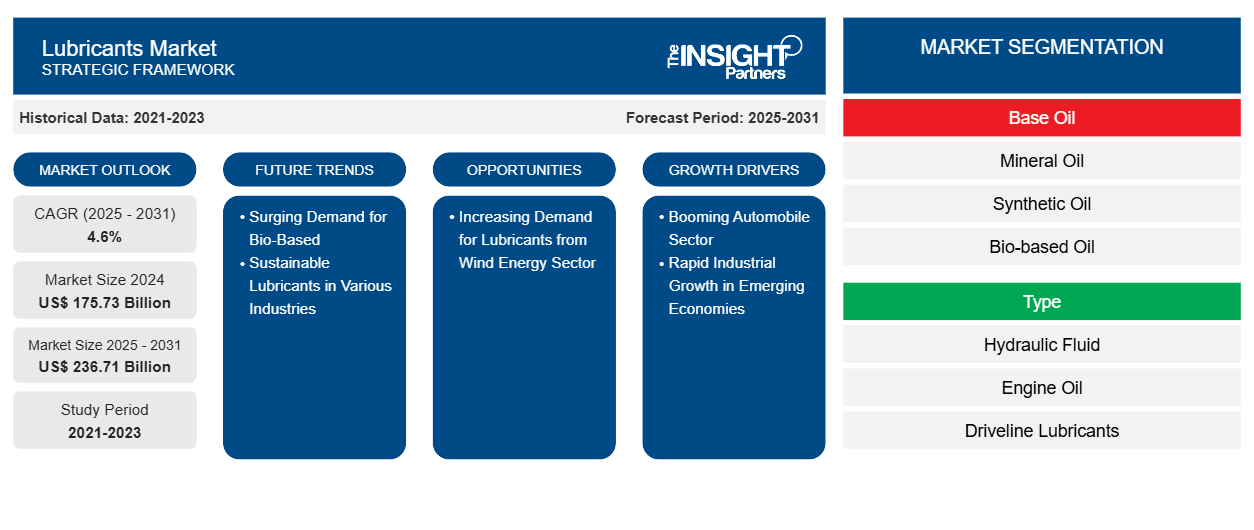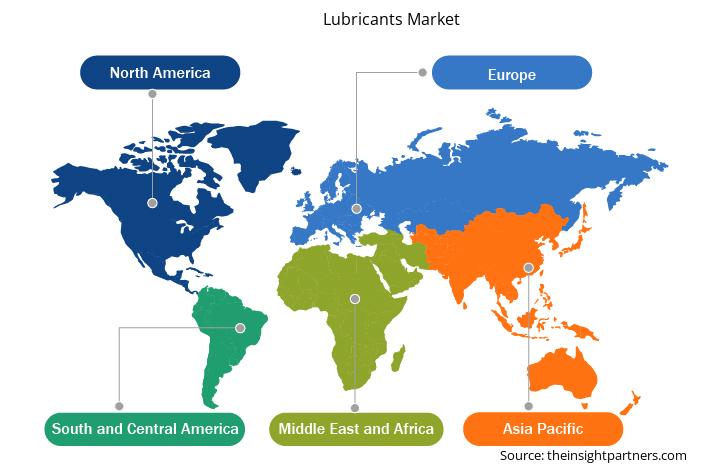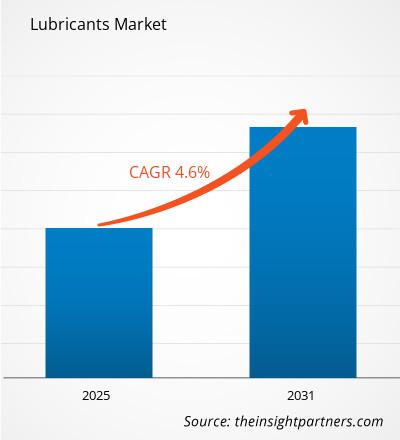Se proyecta que el tamaño del mercado de lubricantes alcance los 236.710 millones de dólares estadounidenses para 2031, frente a los 175.730 millones de dólares estadounidenses de 2024; se espera que registre una tasa de crecimiento anual compuesta (TCAC) del 4,6 % entre 2025 y 2031. Se prevé que la creciente demanda de lubricantes de origen biológico y sostenibles en diversas industrias sea una tendencia clave en el mercado.
Análisis del mercado de lubricantes
Fabricantes a nivel mundial están invirtiendo en mejorar su cadena de suministro para aumentar las ventas de automóviles en regiones en desarrollo. Según la Sociedad de Fabricantes de Automóviles de la India (SIAM), en la India, las ventas de vehículos de pasajeros aumentaron a casi 2,854,242 unidades en noviembre de 2023 desde ~2,409,535 unidades en noviembre de 2022. La industria de fabricación de automóviles de Sudáfrica es la 22.ª más grande del mundo en términos de número de vehículos producidos y es la más grande del continente africano, representando más del ~54% de los vehículos ensamblados en el continente en 2023. Según la Organización Internacional de Constructores de Vehículos Motorizados (OICA), Brasil fue el mayor fabricante y exportador de vehículos ligeros y comerciales en 2023 en América del Sur y Central. El país reportó una producción de casi 2,3 millones de vehículos en 2022. Tradicionalmente, los lubricantes han sido esenciales en los vehículos con motor de combustión interna (ICE), donde reducen la fricción, previenen el desgaste y ayudan a controlar el calor del motor. Sin embargo, el auge de los vehículos eléctricos ha introducido una nueva dinámica en el mercado de lubricantes . Los vehículos eléctricos, a pesar de no contar con motores tradicionales, aún dependen de lubricantes en diversos componentes, como transmisiones, motores y otras piezas del sistema de propulsión. Por ello, el auge de la industria automotriz está acelerando la demanda de lubricantes, lo que contribuye a un mejor rendimiento y una mayor durabilidad de los vehículos.
Descripción general del mercado de lubricantes
Diversos países del mundo están en proceso de industrialización, lo que ha provocado un auge en el uso de maquinaria y equipos en diversos sectores. Industrias como la manufactura, la construcción, la minería y la agricultura dependen en gran medida de maquinaria que requiere lubricantes para un rendimiento óptimo y una larga vida útil. Se prevé que el aumento de la actividad industrial y el crecimiento de las industrias de la construcción y la agricultura incrementen la demanda de lubricantes.
Personalice este informe según sus necesidades
Obtendrá personalización en cualquier informe, sin cargo, incluidas partes de este informe o análisis a nivel de país, paquete de datos de Excel, así como también grandes ofertas y descuentos para empresas emergentes y universidades.
Mercado de lubricantes: Perspectivas estratégicas

-
Obtenga las principales tendencias clave del mercado de este informe.Esta muestra GRATUITA incluirá análisis de datos, desde tendencias del mercado hasta estimaciones y pronósticos.
Impulsores y oportunidades del mercado de lubricantes
El rápido crecimiento industrial en las economías emergentes impulsa el crecimiento del mercado
Diversos tipos de lubricantes, como lubricantes minerales y sintéticos, grasas, aceites para compresores y fluidos de corte, se utilizan en las industrias de petróleo y gas, textil, minería y metalurgia, generación de energía, papel y pulpa, química y petroquímica, agricultura, manufactura, alimentos y bebidas, y farmacéutica. Según datos publicados por Trading Economics en noviembre de 2024, la producción industrial en China aumentó un 5,4 %. A medida que el sector minero experimenta un sólido crecimiento, la necesidad de lubricantes se intensifica, principalmente debido al uso extensivo de maquinaria pesada en las operaciones mineras. Estas máquinas, esenciales para la extracción y el procesamiento de minerales, requieren una lubricación eficiente para garantizar un funcionamiento fluido, reducir el desgaste y prolongar su vida útil. Las actividades mineras, caracterizadas por duras condiciones de operación, someten a un estrés considerable a los componentes de los equipos. Los lubricantes son cruciales para mitigar la fricción, controlar las temperaturas y prevenir la corrosión, mejorando así el rendimiento general y la longevidad de la maquinaria minera. Con la creciente demanda de minerales y metales que impulsa las operaciones mineras, el mercado de lubricantes experimenta un repunte correspondiente a medida que las empresas mineras priorizan el mantenimiento y la optimización de sus equipos.
La creciente demanda de lubricantes del sector de la energía eólica creará oportunidades de crecimiento en el mercado.
La energía eólica se encuentra entre las tecnologías renovables de más rápido crecimiento y tiene un gran potencial de consumo de lubricantes en el sector eléctrico. Según datos publicados por WindEurope, en 2023 Europa instaló 18,3 GW de nueva capacidad eólica y se prevé que instale 260 GW entre 2024 y 2030. Dado que varios países de la región están adoptando las energías renovables, en particular la eólica, la necesidad de lubricantes especializados para garantizar el buen funcionamiento de los aerogeneradores se vuelve crucial. Estos lubricantes mejoran la eficiencia operativa y la vida útil de la compleja maquinaria que interviene en el aprovechamiento de la energía eólica. El creciente sector eólico requiere un suministro fiable y constante de lubricantes de alto rendimiento para mitigar el desgaste, reducir la fricción y prevenir la corrosión en los componentes mecánicos de los aerogeneradores. Esta demanda abre nuevas vías para la investigación y el desarrollo, impulsando la innovación en formulaciones de lubricantes adaptadas a los desafíos específicos que plantea el sector eólico.
Análisis de segmentación del informe de mercado de lubricantes
Los segmentos clave que contribuyeron a la derivación del análisis del mercado de lubricantes son el aceite base, el tipo y la industria de uso final.
- Según el aceite base, el mercado de lubricantes está segmentado en aceite mineral, aceite sintético y aceite de base biológica.
- Por tipo, el mercado está segmentado en fluido hidráulico, aceite de motor, lubricantes de transmisión, fluidos para trabajar metales, grasa, aceites de proceso, refrigerantes y otros.
- En cuanto a la industria de uso final, el mercado se segmenta en automoción, construcción, generación de energía, minería y metalurgia, procesamiento de alimentos, petróleo y gas, sector marítimo y aviación, entre otros. El segmento automotriz se segmenta a su vez en turismos, vehículos comerciales ligeros, vehículos comerciales pesados, entre otros.
Análisis de la cuota de mercado de lubricantes por geografía
El alcance geográfico del informe del mercado de lubricantes se divide principalmente en cinco regiones: América del Norte, Asia Pacífico, Europa, Medio Oriente y África, y América del Sur y Central.
Se espera que Asia Pacífico domine el mercado durante el período de pronóstico. Esta región es un centro neurálgico para la fabricación de automóviles, con una amplia presencia de empresas nacionales e internacionales que operan en ella. Según un informe publicado por la Asociación de Automóviles de Pasajeros de China, en 2022, Tesla Inc. entregó 83.135 vehículos eléctricos fabricados en China, lo que indica un crecimiento en las ventas de vehículos eléctricos en comparación con 2021. Según la Asociación de Fabricantes de Automóviles de China, en 2023 se vendieron aproximadamente 6.000 vehículos eléctricos de pila de combustible en China, un aumento interanual del 72 %. Según la Fundación India para el Valor de Marca, la producción anual de automóviles en 2023 alcanzó los 25,9 millones de vehículos en India. En septiembre de 2024, la producción total de vehículos de pasajeros, vehículos de tres ruedas, vehículos de dos ruedas y cuatriciclos fue de 2.773.039 unidades. Los lubricantes se utilizan en componentes automotrices como motores, transmisiones y diferenciales, donde proporcionan lubricación para reducir la fricción y mejorar la eficiencia del combustible, garantizando posteriormente un rendimiento óptimo y la longevidad de los vehículos.
China, Japón y Corea del Sur son países líderes en el sector de la construcción naval. Las grasas para construcción naval confieren propiedades como resistencia a los elementos y al agua salada corrosiva, resistencia a altas presiones y una mayor vida útil de los componentes del buque.
Perspectivas regionales del mercado de lubricantes
Los analistas de Insight Partners han explicado detalladamente las tendencias y los factores regionales que influyen en el mercado de lubricantes durante el período de pronóstico. Esta sección también analiza los segmentos y la geografía del mercado de lubricantes en Norteamérica, Europa, Asia Pacífico, Oriente Medio y África, y Sudamérica y Centroamérica.

- Obtenga los datos regionales específicos para el mercado de lubricantes
Alcance del informe del mercado de lubricantes
| Atributo del informe | Detalles |
|---|---|
| Tamaño del mercado en 2024 | US$ 175.73 mil millones |
| Tamaño del mercado en 2031 | US$ 236.71 mil millones |
| CAGR global (2025-2031) | 4,6% |
| Datos históricos | 2021-2023 |
| Período de pronóstico | 2025-2031 |
| Segmentos cubiertos |
Por aceite base
|
| Regiones y países cubiertos |
América del norte
|
| Líderes del mercado y perfiles de empresas clave |
|
Densidad de actores del mercado de lubricantes: comprensión de su impacto en la dinámica empresarial
El mercado de lubricantes está en rápido crecimiento, impulsado por la creciente demanda de los usuarios finales debido a factores como la evolución de las preferencias de los consumidores, los avances tecnológicos y un mayor conocimiento de los beneficios del producto. A medida que aumenta la demanda, las empresas amplían su oferta, innovan para satisfacer las necesidades de los consumidores y aprovechan las tendencias emergentes, lo que impulsa aún más el crecimiento del mercado.
La densidad de actores del mercado se refiere a la distribución de empresas o compañías que operan en un mercado o sector en particular. Indica cuántos competidores (actores del mercado) hay en un mercado determinado en relación con su tamaño o valor total.
Las principales empresas que operan en el mercado de lubricantes son:
- Castrol Ltd
- Shell Plc
- Pennzoil
- Quaker State Lubrication Limited
- TotalEnergies SE
- Grupo Repsol
Descargo de responsabilidad : Las empresas enumeradas anteriormente no están clasificadas en ningún orden particular.

- Obtenga una descripción general de los principales actores clave del mercado de lubricantes
Noticias y desarrollos recientes del mercado de lubricantes
El mercado de lubricantes se evalúa mediante la recopilación de datos cualitativos y cuantitativos de investigaciones primarias y secundarias, que incluyen importantes publicaciones corporativas, datos de asociaciones y bases de datos. A continuación, se enumeran algunos de los avances en el mercado de lubricantes:
- Castrol lanzó la campaña "Historias de Amor con el Primer Auto" en el Reino Unido para impulsar el conocimiento de la marca y las ventas. (Castrol Limited, sitio web de la empresa, agosto de 2024)
- Repsol se alió con Tekniker para desarrollar lubricantes con nanotecnología. (Repsol, sitio web de la empresa, septiembre de 2024)
- Repsol lanzó su nuevo envase de lubricante con un 60 % de plástico reciclado. (Repsol, sitio web de la empresa, marzo de 2024)
- Castrol lanzó VECTON, un nuevo lubricante totalmente sintético para vehículos comerciales que cumple con las nuevas especificaciones ACEA para vehículos pesados. (Castrol Limited, sitio web de la empresa, agosto de 2024)
- ExxonMobil expandió la gama de lubricantes y productos químicos de la marca Mobil, priorizando la innovación en productos de calidad. (ExxonMobil, Noticias de la empresa, septiembre de 2023)
- Shell Lubricants adquirió MIDEL y MIVOLT, con sede en el Reino Unido, lo que fortaleció su cartera de productos para los sectores de energía y renovables. (Shell, Noticias de la empresa, octubre de 2023)
Cobertura y resultados del informe del mercado de lubricantes
El informe "Tamaño y pronóstico del mercado de lubricantes (2021-2031)" ofrece un análisis detallado del mercado que abarca las siguientes áreas:
- Tamaño del mercado de lubricantes y pronóstico para todos los segmentos clave del mercado cubiertos bajo el alcance
- Tendencias del mercado de lubricantes, así como dinámicas del mercado como impulsores, restricciones y oportunidades clave
- Análisis detallado de las cinco fuerzas de Porter y FODA
- Análisis del mercado de lubricantes que cubre las tendencias clave del mercado, el marco del país, los principales actores, las regulaciones y los desarrollos recientes del mercado.
- Análisis del panorama industrial y de la competencia que abarca la concentración del mercado, el análisis de mapas de calor, los actores destacados y los desarrollos recientes en el mercado de lubricantes.
- Perfiles detallados de empresas
- Análisis histórico (2 años), año base, pronóstico (7 años) con CAGR
- Análisis PEST y FODA
- Tamaño del mercado, valor/volumen: global, regional y nacional
- Industria y panorama competitivo
- Conjunto de datos de Excel
Informes recientes
Informes relacionados
Testimonios
Razón para comprar
- Toma de decisiones informada
- Comprensión de la dinámica del mercado
- Análisis competitivo
- Información sobre clientes
- Pronósticos del mercado
- Mitigación de riesgos
- Planificación estratégica
- Justificación de la inversión
- Identificación de mercados emergentes
- Mejora de las estrategias de marketing
- Impulso de la eficiencia operativa
- Alineación con las tendencias regulatorias






















 Obtenga una muestra gratuita para - Mercado de lubricantes
Obtenga una muestra gratuita para - Mercado de lubricantes